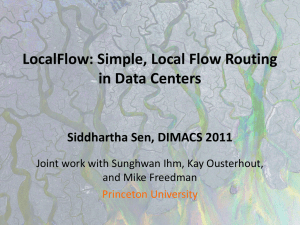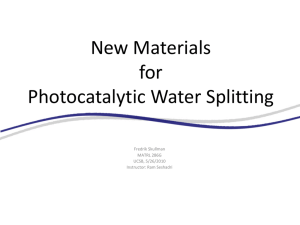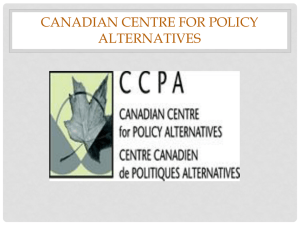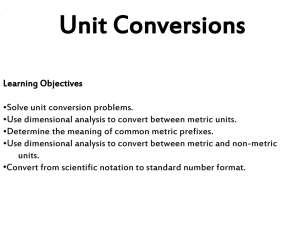Topological Relations from Metric Refinements
advertisement
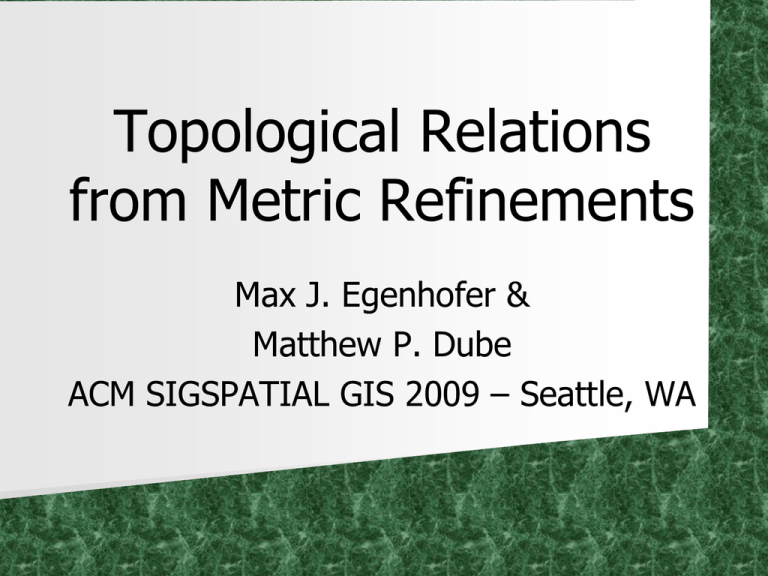
Topological Relations from Metric Refinements Max J. Egenhofer & Matthew P. Dube ACM SIGSPATIAL GIS 2009 – Seattle, WA The Metric World… How many? How much? The Not-So-Metric World… When geometry came up short, math adapted Distance became connectivity Area and volume became containment Thus topology was born Metrics still here! Interconnection Topology is an indicator of “nearness” – Open sets represent locality Metrics are measurements of “nearness” – Shorter distance implies closer objects Euclidean distance imposes a topology upon any real space Rn or pixel space Zn The $32,000 Question: Metrics have been used in spatial information theory to refine topological relations No different; different only in your mind! - The Empire Strikes Back Is the degree of the overlap of these objects different? The $64,000 Question: The reverse has not been investigated: Can metric properties tell us anything about the spatial configuration of objects? Importance? Why is this an important concern? – Instrumentation – Sensor Systems – Databases – Programming 9-Intersection Matrix B Interior A Interior A Boundary A Exterior B Boundary B Exterior Neighborhood Graphs d Moving from one configuration directly to another without a different one in between Continue the process and we end up with this: disjoint meet disjoint m o cB i meet cv e ct overlap Relevant Metrics A B Inner Area Splitting Inner Area Splitting A IAS B area(A B) area(A) Outer Area Splitting Outer Area Splitting A OAS area(A B ) area(A) B Outer Area Splitting Inverse A B Outer Area Splitting Inverse OAS -1 = area(A B) area(A ) Exterior Splitting Exterior Splitting a rea(b o u n d ed (A B ) ) A ES = a rea(A) B Inner Traversal Splitting Inner Traversal Splitting A ITS = B length(A B) length(A ) Outer Traversal Splitting Outer Traversal Splitting A OTS = length(A B ) length(A) B Alongness Splitting A B Alongness Splitting AS = length(A B) length(A) Inner Traversal Splitting Inverse Inner Traversal Splitting Inverse A -1 ITS = B length(A B) length(A) Outer Traversal Splitting Inverse Outer Traversal Splitting Inverse A length(A B) 1 OTS length(A) B Splitting Metrics Exterior Splitting Outer Area Splitting Outer Traversal Splitting Alongness Splitting Inner Traversal Splitting Inverse Inner Traversal Splitting A B Outer Area Splitting Inverse Outer Traversal Splitting Inverse Inner Area Splitting Refinement Opportunity B Interior B Boundary B Exterior A Interior IAS ITS-1 OAS A Boundary ITS AS OTS A Exterior OAS-1 OTS-1 ES Refinement Opportunity How does the refinement work in the case of a boundary? Refinement is not done by presence; it is done by absence Consider two objects that meet at a point. Boundary/Boundary intersection is valid, yet Alongness Splitting = 0 Closeness Metrics Expansion Closeness Contraction Closeness Dependencies Are there dependencies to be found between a well-defined topological spatial relation and its metric properties? To answer, we must look in two directions: – Topology gives off metric properties – Metric values induce topological constraints disjoint ITS = 0 OAS, OTS = 1 ITS-1 = 0 OAS-1, OTS-1 = 1 IAS = 0 AS = 0 ES = 0 Inner Traversal Splitting 0 0 (0,1) (0,1] 1 0 0 0 Key Questions: Can all eight topological relations be uniquely determined from refinement specifications? Can all eight topological relations be uniquely determined by a pair of refinement specifications, or does unique inference require more specifications? Do all eleven metric refinements contribute to uniquely determining topological relations? Combined Approach Find values of metrics relevant for a topological relation Find which relations satisfy that particular value for that particular metric Combine information IAS = 1 ITS-1 = 0 OAS = 0 0 < EC < 1 ITS = 1 AS = 0 OTS = 0 CC = 0 0 < EC < 1 & OTS = 0 0 < OAS-1 0 < OTS-1 Sample method for inside ES = 0 = Possible Dependency = Not Possible Redundancies Are there any redundancies that can be exploited? Utilize the process of subsumption Construct Hasse Diagrams meet Hasse Diagram Specificity of refinement: Low at top; high at bottom Redundant Information Explicit Definition Hasse Diagrams disjoint meet overlap equal coveredBy inside covers contains Fewest Refinements Minimal set of refinements for the eight simple region-region relations: OTS-1 = 0 0 < OTS-1 IAS = 0 0 < IAS < 1 IAS = 1 EC = 0 ITS = 0 0 < EC < 1 AS < 1 CC = 0 0 < CC < 1 coveredBy Intersection of all graphs of values produces relation Can we get smaller? – Coupled with inside – Coupled with equality What metrics can strip each coupling? – EC can strip inside – ITS/AS can strip equality Key Questions Answered: All eight topological relations are determined by metric refinements. covers and coveredBy require a third refinement to be uniquely identified. Some metric information is redundant and thus not necessary. How can this be used? spherical relations 3D worlds metric composition sensor informatics sketch to speech Questions? I will now attempt to provide some metrics or topologies to your queries! National Geospatial Intelligence Agency National Science Foundation
